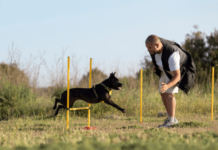Last Updated on May 18, 2024 by Dogs Vets
Dog obedience training in London isn’t just about transforming your disobedient pup into a model citizen. It unlocks a world of benefits that enrich both your dog’s life and your relationship with them.
- Improved Mental Stimulation: Training exercises your dog’s mind, keeping them mentally sharp and preventing boredom. This can be particularly beneficial for intelligent breeds that crave mental challenges.
- Reduced Anxiety: A well-trained dog feels secure knowing what’s expected of them. Following commands and routines provides a sense of control and reduces anxiety in unfamiliar situations.
- Stronger Recall: A reliable recall ensures your dog returns to you when called, keeping them safe during walks and adventures off-leash in designated areas.
- Enhanced Confidence: Mastering commands boosts your dog’s confidence and self-esteem. Successfully completing tasks strengthens their bond with you and fosters a sense of accomplishment.
- Opens Doors to Activities: Obedience training is often a prerequisite for enrolling in dog-friendly activities like agility classes, doggy daycare, or attending dog-friendly events.
The Importance of Choosing a Qualified Dog Trainer in London
With so many dog trainers in London, selecting the right one is crucial for a successful training experience. Here are some key factors to consider:
- Qualifications and Experience: Look for trainers with certifications from reputable organizations like the Kennel Club or the Association of Pet Dog Trainers. Experience working with your dog’s breed is a plus.
- Training Philosophy: Choose a trainer who aligns with your preferred training methods. Positive reinforcement methods are generally considered more humane and effective for most dogs.
- Communication Style: Ensure the trainer uses clear and concise communication that you understand. Observe how they interact with dogs during consultations or demonstrations.
Here are some benefits of starting dog obedience training early:
- Develop Good Habits: Early training lays the foundation for good behavior throughout your dog’s life.
- Prevent Behavioral Issues: Addressing unwanted behaviors like chewing or jumping early on prevents them from becoming ingrained habits.
- Socialization: Puppy training classes provide valuable opportunities for your pup to interact with other dogs safely, promoting confidence and social skills.
Finding the Right Puppy Training Class in London
Many reputable dog trainers in London offer puppy training classes specifically designed for young pups.
Here’s what to look for:
- Small Class Sizes: Smaller classes allow for more individualized attention and ensure your puppy doesn’t become overwhelmed.
- Positive Reinforcement Methods: Look for classes that utilize positive reinforcement techniques to keep training sessions fun and engaging for your pup.
- Experienced Trainers: Choose a trainer with experience working with puppies and a positive approach to dog training.
Financing Dog Obedience Training in London: Making it Work
Dog obedience training can be an investment, but the long-term benefits for you and your dog are invaluable.
Here are some ways to make dog obedience training in London more affordable:
- Group Classes: Group classes are the most cost-effective option compared to private training or in-home sessions.
- Package Deals: Many trainers offer package deals for multiple training sessions, which can save you money in the long run.
- Free Resources: Utilize free online resources like video tutorials and training guides to supplement your in-person training sessions.
Beyond London: Exploring Dog-Friendly Activities After Training
Once you’ve mastered your dog obedience training, London offers a plethora of dog-friendly activities to enjoy with your well-behaved companion:
- Explore London’s Parks: From the sprawling greenery of Richmond Park to the scenic trails of Regent’s Park, London boasts numerous parks perfect for off-leash adventures (in designated areas).
- Hit the Pub (with a Dog Patio): Many pubs in London welcome well-behaved dogs, allowing you to enjoy a pint and some socialization with your furry friend.
- Take a Hike: The outskirts of London offer plenty of hiking trails perfect for exploring with your dog. Be sure to check leash regulations before heading out.
- Visit a Dog-Friendly Cafe: Several cafes in London cater to canine customers, offering pupcakes and other dog-friendly treats.
Conclusion: Building a Lifelong Bond Through Dog Obedience Training in London
Dog obedience training in London is more than just teaching your dog commands. It’s about creating a language of communication, fostering trust, and building a strong, lifelong bond with your furry companion.
With the right approach and dedication, you can transform your rambunctious pup into a well-mannered and happy dog, ready to conquer the bustling streets and hidden green spaces of London together.
Beyond the Basics: Advanced Training Options for the Discerning Dog
Once you’ve mastered basic obedience, London offers a variety of advanced training options to keep your canine companion challenged and engaged:
- Gundog Training: This specialized training focuses on retrieving skills, perfect for breeds like Labradors or Cocker Spaniels bred for hunting.
- Detection Dog Training: Train your dog to detect specific scents, like explosives or narcotics, through engaging scent work activities.
- Canine Fitness: Keep your dog physically fit and mentally stimulated with agility training classes or canine fitness programs.
- Therapy Dog Training: Train your dog to provide emotional support to others by volunteering at hospitals,retirement homes, or schools.
Finding the Perfect Trainer: Resources for Dog Obedience Training in London
- The Kennel Club: The Kennel Club offers a “Find a Trainer” tool to locate trainers in your area https://www.thekennelclub.org.uk/.
- The Association of Pet Dog Trainers: The APDT website has a search function to find qualified trainers https://apdt.com/.
- Online Reviews: Read online reviews and testimonials from previous clients to get insights into different trainers’ experiences and teaching styles.
Conclusion: Investing in Your Dog’s Happiness with Dog Obedience Training in London
Dog obedience training in London is an investment in your dog’s happiness, well-being, and your relationship with them.It equips you with the tools to navigate the exciting and sometimes overwhelming world of London life together.
From conquering the bustling streets to exploring hidden green havens, a well-trained dog is your perfect companion for every adventure. So, take the first step towards a harmonious future and embark on your dog obedience training journey in London today!
Fact Check
We strive to provide the latest valuable information for pet lovers with accuracy and fairness. If you would like to add to this post or advertise with us, don’t hesitate to reach us. If you see something that doesn’t look right, contact us!

















